It is expected to grow with a CAGR of 7.4% from 2025 USD 1,979.2 Million to USD 4,041.4 Million by 2035. As climate change and land scarcity put pressure on global food production systems, farmers and agrotech companies are turning to bio stimulants and plant growth regulators, including cytokinins, to improve yields, crop quality and plant resilience to harsh conditions, including drought, heat, and disease.
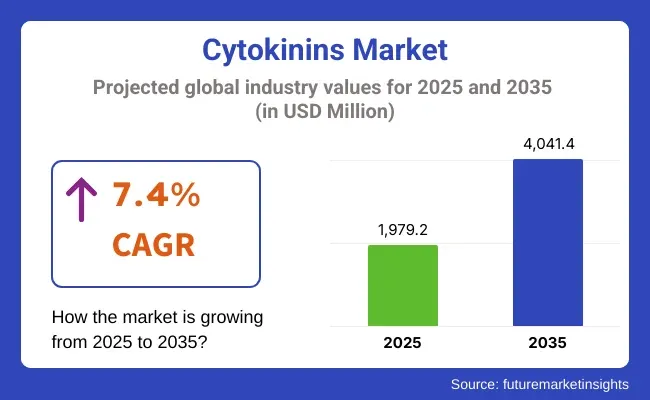
Market Metrics
| Metric | Value |
|---|---|
| Market Size (2025E) | USD 1,979.2 Million |
| Market Value (2035F) | USD 4,041.4 Million |
| CAGR (2025 to 2035) | 7.4% |
Cytokinins market will record significant growth between 2025 to 2035 owing to growing global emphasis on crop productivity, sustainable agriculture and improving the overall health of plants. As a group of plant hormones, cytokinins are essential for promoting cell division, shoot initiation, leaf expansion and inhibiting senescence, thus constituting a key element in modern agricultural practices. Increasing adoption of plant tissue culture, precision farming, and organic crop solutions are also accelerating cyberin demand.
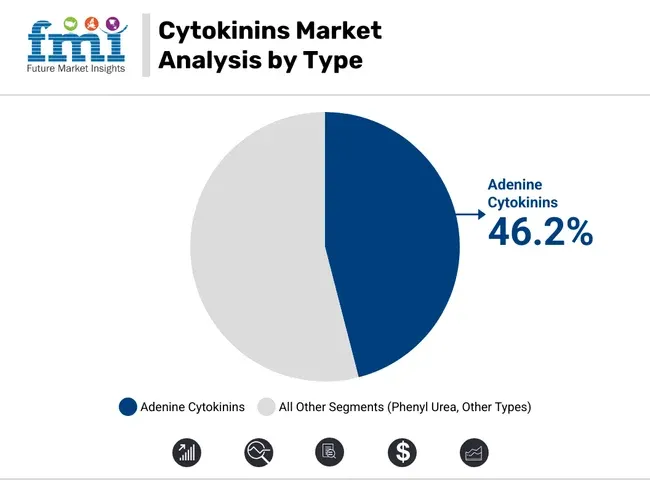
| By Type | Market Share (2025) |
|---|---|
| Adenine Cytokinins | 46.2% |
Adenine cytokinins are projected to account for a major share of the global cytokinins market owing to its most widely studied and employed variant in agricultural and horticultural practices. Examples include zeatin and kinetin, which tend to be bioactive in plants due to their compatibility with plant metabolism to regulate essential growth processes.
Adenine cytokinins, which are favoured by farmers and agronomists due to their effectiveness in improving shoot formation, delaying senescence, and enhancing plant vigor, are now also popular because of the prevalence of nucleotides in plant tissues.
These chemicals are vital for tissue cultures and micro propagation, particularly to induce cell division and shoot proliferation. Now, as skimming weeds and disease-resistant, high-yielding crop types are still among the focuses of contemporary agriculture, adenine cytokinins provide a proven remedy, stimulating luxuriant growth in vegetative tissues without harmful effects on the environment. This, coupled with their compatibility with other plant growth regulators and fertilizers, makes them key components of modern crop management solutions.
Additionally, continuous research & developments in synthetic biology have diversified the range of adenine cytokinin derivatives, catering to a variety of crops and climatic conditions. With the rise of sustainable agriculture, adenine cytokinins have also been important in ensuring healthier crops with a better ability to withstand abiotic stress, pest, and diseases.
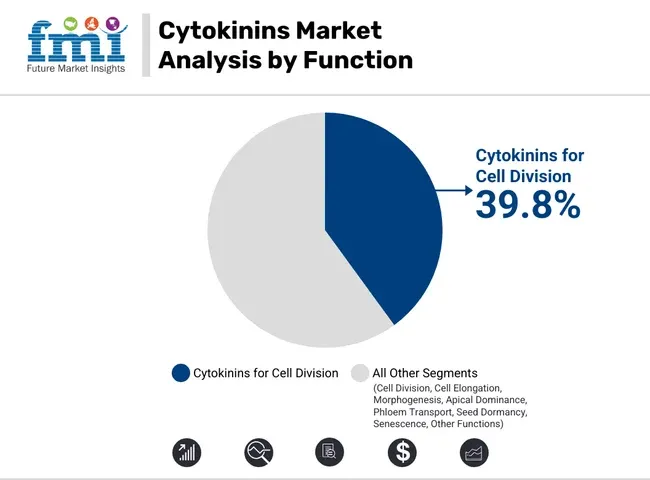
| By Function | Market Share (2025) |
|---|---|
| Cytokinins for Cell Division | 39.8% |
Cytokinins that are used specifically for cell division promotion have significant share in the market owing to their essential function in plant growth and tissue recovery. These cytokinins turn on genes related to mitosis, leading to abundant cell division in both natural and artificial settings. They are essential for plant biotechnology, particularly in laboratories for cloning, hybridization, and research on genetically modified crops!
These cytokinins are applied at early growth stages of commercial crops to promote robust stem structure and leaf shoot development which contributes to the quantity and quality of crop yield. This is particularly useful in high-value crops, such as fruits, vegetables, and ornamental plants, where uniformity in growth and size is critical for market acceptance.
These cytokinins also accelerate regenerative cellular activity, allowing the recovery of stressed crops with nutrient deficiencies, drought, or transplant shock. In tissue-culture systems, they are used as the foundation of propagation guidelines that enable the generation of healthy, genetically uniform plants that can be scaled for mass production.
As the global demand for agricultural productivity increases, so does the demand for cell division-targeting cytokinins. The strategic applications of cytokinins in agriculture are prefacing cutting-edge biotechnologies founded by the involvement of governments and private enterprises.
Limited Awareness and Market Penetration in Developing Regions
Cytokinins provide a myriad of ecological advantages but their utilization in low-income and developing agricultural regions is still scarce due to insufficient awareness, poor distribution channels, and high product costs. Small-scale farmers aren’t as familiar with plant growth regulators or might not be willing to invest in the latest bio stimulants with uncertain returns.
Moreover, varying levels of R&D activity by country and inconsistent regulatory frameworks further limit access to markets. Specific education programs, localized demonstration trials, and supportive subsidy structures will build trust and drive product adoption over these hurdles.
Integration into Organic and Sustainable Agriculture
The global trend towards organic, regenerative and low-residue agriculture will also drive opportunities for cytokinin-based products in particular natural in origin or bio-based formulations. As consumers and regulators are increasingly demanding safer and more sustainable inputs in the agricultural sector, cytokinins are entering the spotlight as non-toxic, environmentally friendly alternative to synthetic growth promoters.
This represents a great opportunity for manufacturers of certified organic cytokinin formulations and solutions specifically suited for high-value produce like fruits and vegetables, as well as ornamentals. Furthermore, improvements in nano-encapsulation, foliar application technologies, and seed treatments are further expanding the uses of cytokinins in modern agronomic systems.
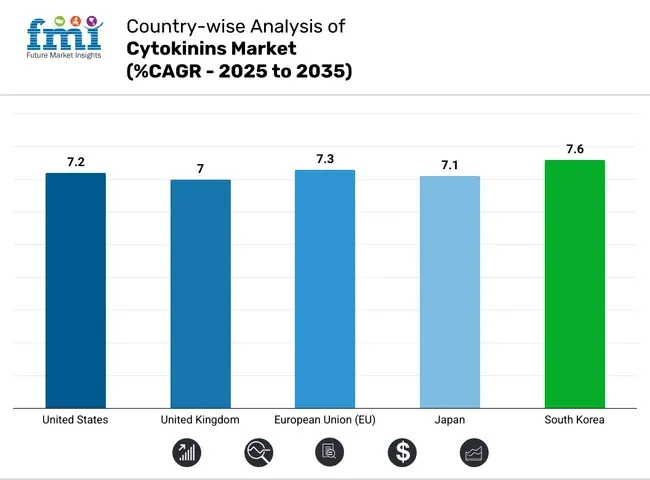
The United States cytokinins market is expected to register a CAGR of 7.2%, during the forecast period. It is primarily due to the growing adoption of sustainable agriculture practices in the country and the higher application of plant growth regulators to improve the crop yield. Because cytokinins encourage cellular division and senescence delay, the agronomic potential of cytokinins is sought heavily both at home and abroad, particularly in USA-based precision farming and bio stimulants.
According to government specifications for the reduction of chemical pesticides and organic farming, are also providing an impetus for the cytokinins market, across segments such as fruits, vegetables, and row crops.
| Country | CAGR (2025 to 2035) |
|---|---|
| United States | 7.2% |
The cytokinins market in the United Kingdom is anticipated to expand at a CAGR of 7.0% till 2035. Key factors driving growth of the market include commitment to green agriculture and growing preference toward bio-based inputs.
Cytokinins are increasingly being incorporated into cutting-edge agronomic practices and receiving extensive attention for their potential to improve resilience of crops under climate-induced stress and plant health. At the same time, research institutions and local agro-tech firms are actively working on next-generation formulations that enhance the nutrient uptake and flowering of cereals and horticultural crops.
| Country | CAGR (2025 to 2035) |
|---|---|
| United Kingdom | 7.0% |
From 2025 to 2035, the European Union cytokinins market is expected to grow at a CAGR of 7.3%. Stringent environmental policies and restrictions on synthetic agrochemicals by EU are fuelling demand for naturally derived plant growth regulators.
With EU Green Deal initiatives, farmers from member nations are moving towards bio stimulant based solutions containing cytokinins for crop productivity. They are likely to be some of the first in the world to use these biologically derived inputs in conventional and organic farming and are joining countries such as France, Germany and the Netherlands in leading the world on this front.
| Region | CAGR (2025 to 2035) |
|---|---|
| European Union | 7.3% |
The cytokinins market in Japan is anticipated to expand at a CAGR of 7.1% during the forecast period. Plant growth regulators like cytokinins are being employed by one of the most futuristic agricultural sectors in the world to combat problems concerning ageing farm communities and scarce farming land.
Cytokinins are now being applied to enhance flowering and fruit formation in high-value crops like rice, strawberries, and ornamental plants. Moreover, due to leading research and formulation development of Japanese agrochemical companies, the role of cytokinins is expanding in integrated crop management systems.
| Country | CAGR (2025 to 2035) |
|---|---|
| Japan | 7.1% |
The South Korea Cytokinins Market would witness market growth of 7.6% CAGR during the forecast period (2025 to 2035). South Korea’s high-tech agricultural industry is increasingly calling for plant growth regulators to promote productivity especially among greenhouse growers and those with high-density plantations.
Cytokinins have already, begun to scale in high value specialty crops such as ginseng, leafy greens, and fruits where they promote chlorophyll levels and shoot growth. Favourable government initiatives and funding for agro-biotech start-ups to fund new plants are also anticipated to aid in market penetration through domestic farms.
| Country | CAGR (2025 to 2035) |
|---|---|
| South Korea | 7.6% |
Cytokinins Market is largely competitive due to presence of new-age plant growth regulators and Increase global demand for yield-oriented agrochemicals. From the perspective of biostimulant development, companies are expanding bio stimulant portfolios allowing companies to become more effective in increasing formulation and contribute to sustainable farming goals.
Major players in the agrochemicals space concentrate on formation of strategic alliances, regional expansion, and product diversification on the basis of R&D activities, in a bid to improve their competitive position and fulfil evolving agricultural needs.
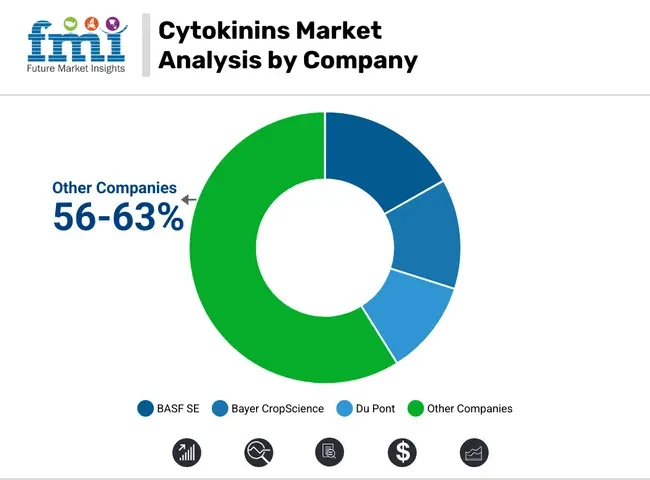
BASF SE (15-18%)
BASF drives cytokinin innovation through a robust pipeline of plant health solutions. The company’s strategy emphasizes integrated crop systems and sustainable yield enhancement, with a focus on both macro and micro crops across North America, South America, and Europe.
Bayer CropScience (12-14%)
Bayer accelerates its growth in the cytokinins space by aligning with global precision agriculture practices. Its commitment to digital farming tools and crop-specific cytokinin formulations enables the company to cater to variable field conditions and optimize agronomic outcomes.
Du Pont (10-12%)
Du Pont integrates cytokinin technology with crop protection and nutrient management platforms. The company delivers customized solutions, particularly for row crops and cereals, through partnerships with agronomic service providers and tech-integrated delivery systems.
Crop Care Australasia Pvt Ltd.
Crop Care Australasia maintains a strong position in the Asia-Pacific market by offering efficient cytokinin foliar formulations. The company targets specialty and high-value crops including grapes, apples, and leafy greens, supporting precision spraying and rapid absorption.
Other Key Players (56-63% Combined)
These companies contribute to market diversity with varying regional strengths, formulation capabilities, and distribution partnerships:
The overall market size for the Cytokinins Market was USD 1,979.2 Million in 2025.
The Cytokinins Market is expected to reach USD 4,041.4 Million in 2035.
The demand is driven by rising global food demand, increasing adoption of plant growth regulators in agriculture, growing awareness of crop productivity enhancement, and expansion of organic and precision farming practices.
The top 5 countries driving market growth are the USA, UK, Europe, Japan and South Korea.
The Adenine Cytokinins segment is expected to command a significant share over the assessment period.






Full Research Suite comprises of:
Market outlook & trends analysis
Interviews & case studies
Strategic recommendations
Vendor profiles & capabilities analysis
5-year forecasts
8 regions and 60+ country-level data splits
Market segment data splits
12 months of continuous data updates
DELIVERED AS:
PDF EXCEL ONLINE

Thank you!
You will receive an email from our Business Development Manager. Please be sure to check your SPAM/JUNK folder too.
Chat With
MaRIA